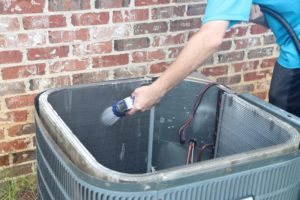Dust storm just pass through? Your pool filter working overtime to pump all the dust out? Cars caked in dust? Well, get to cleaning up but don’t forget that critical component to your home you often don’t see – yes, that’s right, your air conditioner! Whether these units are behind the house or on the roof, the old saying “out of sight, out of mind” applies. But AC units take a beating in dust storms as well, and unlike your patio furniture, being covered in dirt can drastically hurt their performance! This time on the ACE Home Services blog, let’s talk about how to clean air conditioners following a dust storm.
How to Clean Air Conditioners Post Dust Storm
No matter how well-sealed up your home is, your HVAC system can suffer from the dust storms simply because the most crucial component of it, the actual air conditioner unit itself, sits outside the home. The unit will suffer performance and efficiency problems, and the comfort of your home (and wallet) will suffer with it. So don’t sit back and relax now that the storm has passed, it’s time to get cleaning!
Clean Your Air Filters (and Keep ‘em That Way!)
Filters work best when they are completely clear, and the airflow is unrestricted – go figure! When the filter is covered in dirt and dust it becomes clogged, minimizing the amount of airflow that is possible which, as you might imagine, can cause a bunch of headaches down the line, both for the unit and your home. Changing filters is easy so make sure you make it a regular routine, usually every month or so. However, when dust storms come rolling in it’s a good idea to take extra efforts afterward and ensure your filter is fresh. There’s bound to be more dust than usual flowing through your vents!
Where Can I Buy AC Filters? We Recommend: Pleated filters! Pleated filters will last much longer than flat filters, they have a larger surface area, so they are able to capture more dust. They may cost a bit more per filter, but the performance difference is dramatic!

Clean the Evaporator Coils and Fans
If you want to have a clean air conditioner in the dusty state of Arizona, you need to make sure your evaporator coil is getting checked out at least every six months! This coil is inside the air conditioner – already nervous? That’s okay call professionals, we do this sort of thing all the time!
The evaporator coils cool the air that moves through the unit, as it does so it’s possible for condensation to build up on the coil. This allows dust and grime to grab onto the coil and hold tight. But that’s not all, this build-up can create the ‘perfect’ environment for mold to grow in your air system. Yeah, that’s no good.
Equally important is cleaning the fan blades of the blower. These can collect dust a well and a whole monsoon season dust storm is sure to give them a quick coat. These components require special care to keep clean, often including specifically formulated chemical solutions.
When it comes to servicing your AC Unit, Call The Professionals at ACE
Check Your Coils and Fins
As with every other part of the HVAC system, good airflow is required for the best performance. The portion of your unit that sits outdoors will have condenser coils and blade fins that can collect a ton of dust from the dust storms. Cleaning the coils is easy enough though! Just give it a blast of water from the house and it will clear most dust, no problem.
While you’re inspecting the outdoor component of your unit, check to see if any of the fins are bent or damaged. These fins are incredibly fine and they’re what allows the heat to be released outdoors from your HVAC. When these fins are bent or damaged, they won’t be able to release the heat like they need to.
Make sure your unit is clear from any nearby vegetation and debris as well. Your grass should be trimmed back, branches, leaves, or palm fronds all removed. Dust storms mean wind and if there’s nearby debris that wind can easily pick it up and damage your HVAC.
While you’re at it, the rest of your home could probably use some post-storm care too!

Post Dust Storm Home Cleaning
After a haboob, your house will need some TLC. Thankfully, it’s just dust so most everything can be handled easily, with a bit of elbow grease and water. Head to your windows and give them a wipe down. Sweep your walkways and porch to get the dust away from your doors. So long as you kept your windows and doors closed during the storm, you’re probably safe on the amount of dust that came inside, but clearing the area around your doors will keep any from sneaking its way in.
It’s likely your car got a coating of dust too, clean your windshield and pay particular attention to the nozzles where windshield wiper fluid is sprayed. These can get full of dust and clog up on you.
With your AC and home cleaned the only thing left is to be prepared for the next storm. There are a few things you can do today to help the next time the storm clouds roll in.
Pre-Storm Prep
Seal Up Your Home
With everything cleaned and ready, take a look around your home and make sure there are no gaps or missing insulation/weather stripping that leaves your home open to the outdoor air. If so get it fixed up! Any gaps left unchecked will let dust blow its way straight into your home to get sucked up by your HVAC system, not to mention what the lack of insulation will do to your energy bills! Get it sealed up tight, save energy, save money, and save your HVAC from dealing with it.
Turn Your AC Off
Alright, so this step is pretty much an immediate pre-storm step. When you see those big dust clouds rolling in, head over to your thermostat and turn the AC to off! It might be a little uncomfortable after all dust storms don’t tend to hit us in the fall, but hey that’s what fans inside are for! If your AC isn’t running when the storm hits, then it won’t suck up dirt deep into the system. There’s also the chance for a power outage to hit during the storms (it’s not guaranteed but common enough to mention here) and having your AC turned off at the time will help prevent it from getting hit with the outage and damaging its performance.
With all that handled you should be in tip-top shape to handle any dust storms Arizona throws your way! Need help? HVAC system need a tune-up? Whatever you need ACE Home Services is here for you! Schedule your service today and our expert technicians will be on their way in no time!
